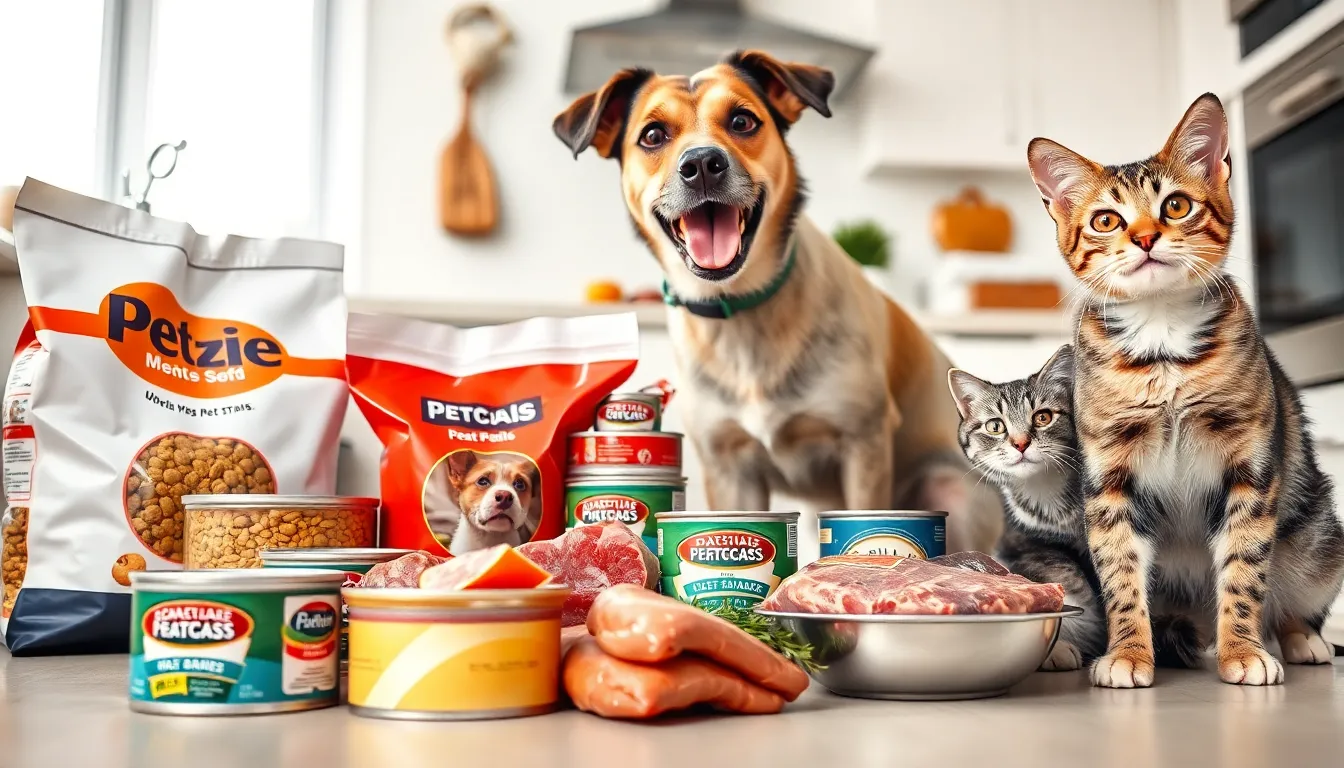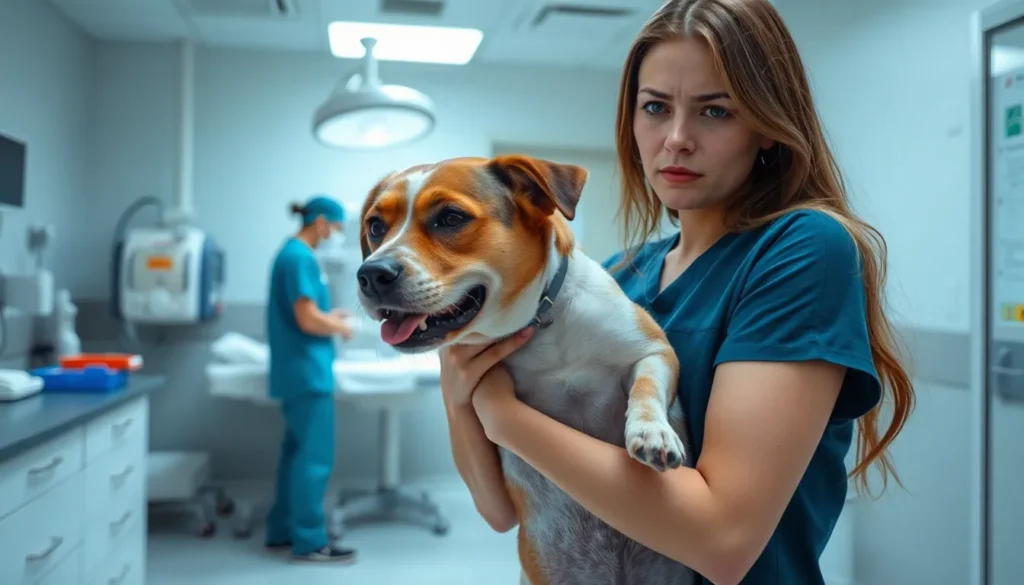When it comes to keeping pets healthy and happy, nutrition plays a crucial role. Just like humans, pets thrive on a balanced diet tailored to their specific needs. With so many options available, navigating the world of pet nutrition can feel overwhelming for pet owners. Understanding what to feed a furry friend is essential for their overall well-being.
This article dives into expert advice on pet nutrition, offering insights into the best practices for feeding dogs and cats. From deciphering ingredient labels to recognizing the importance of portion control, readers will discover how to make informed choices for their pets. With the right knowledge, pet owners can ensure their companions lead long, vibrant lives filled with energy and joy.
Table of Contents
ToggleUnderstanding Pet Nutrition
Proper nutrition significantly impacts a pet’s health and longevity. It forms the foundation for energy, growth, and overall well-being.
The Importance of Proper Nutrition
Proper nutrition ensures pets receive essential nutrients that support bodily functions. Nutrients like proteins, carbohydrates, fats, vitamins, and minerals contribute uniquely to health. Balanced diets enhance immune function, promote healthy skin and coats, and improve digestion. Proper hydration plays a critical role; fresh water needs to be accessible at all times. Regular assessment of dietary needs, based on age, breed, and activity level, optimizes health outcomes.
Common Nutritional Myths
Common nutritional myths can mislead pet owners regarding their pets’ diets. Many believe that dogs can thrive on a vegetarian diet, which can lead to nutrient deficiencies. Cats, being obligate carnivores, require specific proteins found in animal products. It’s also a misconception that all grains are harmful; some grains provide beneficial fiber and nutrients. Additionally, the notion that pets can safely consume certain human foods, such as chocolate, is false and dangerous. Understanding these myths aids in making informed dietary choices for pets.
Types of Pet Food

Understanding different types of pet food helps in making informed choices for pets’ diets. Pet food primarily falls into two categories: dry and wet, with raw diets gaining popularity for their purported benefits.
Dry vs. Wet Food
Dry food, also known as kibble, contains less moisture, typically around 10%. It offers convenience, affordability, and long shelf life. Dry food often promotes dental health as its texture can reduce plaque buildup. Wet food, on the other hand, contains 70-80% moisture, making it more palatable and attractive to pets. It aids in hydration and can be beneficial for pets with certain health issues. Both types provide essential nutrients, but it’s important to choose brands that offer a balanced mix of proteins, fats, and carbohydrates, ensuring alignment with the pet’s specific dietary needs.
Raw Diets and Their Benefits
Raw diets, also referred to as BARF (biologically appropriate raw food), focus on feeding pets uncooked meats, bones, fruits, and vegetables. Proponents claim several benefits, including improved coat condition, higher energy levels, and better digestion. Raw diets aim to mimic the nutritional profile of wild ancestors, potentially enhancing overall well-being and vitality. However, raw diets can pose risks, including bacterial contamination and dietary imbalance. Pet owners must consult veterinarians before transitioning pets to a raw diet, ensuring it appropriately meets nutritional requirements while considering safety and hygiene.
Nutritional Needs for Different Pets
Different pets require tailored nutritional approaches to ensure optimal health. Understanding the specific dietary needs of each animal is crucial for their growth and well-being.
Dogs: Essential Nutrients
Dogs thrive on a balanced diet rich in essential nutrients. Key components include:
- Proteins: Vital for muscle growth and repair, proteins should constitute at least 18-25% of a dog’s diet, depending on age and activity level.
- Fats: Healthy fats supply energy and support skin and coat health. A diet containing 8-15% fat is appropriate, with sources like fish oil and chicken fat being highly beneficial.
- Carbohydrates: While not essential, carbohydrates provide energy and aid digestion. Ingredients such as sweet potatoes and brown rice serve as excellent carbohydrate sources.
- Vitamins and Minerals: Key for metabolic processes, a balanced mix of vitamins (A, D, E, K) and minerals (calcium, phosphorus) should be included based on specific dietary formulas.
Regularly assessing these components helps in meeting individual health needs, particularly during various life stages and activity levels.
Cats: Unique Dietary Requirements
Cats possess unique nutritional needs that differ significantly from dogs. Important dietary elements include:
- Proteins: Cats require a higher protein intake, constituting around 26-30% of their diet, as they are obligate carnivores, meaning they thrive on animal-based protein.
- Taurine: An essential amino acid, taurine supports heart and eye health. Cat food must contain adequate levels to prevent deficiencies.
- Fats: Fats should account for 9-15% of their diet, providing energy and promoting skin and coat health. Omega-3 and omega-6 fatty acids are critical.
- Vitamins and Minerals: Cats need specific vitamins like B vitamins and minerals such as zinc and magnesium to ensure proper bodily function.
Feeding cats a species-appropriate diet that meets these requirements helps maintain their health and longevity.
Reading Pet Food Labels
Reading pet food labels helps pet owners make informed choices regarding their pet’s nutrition. Understanding the components ensures pets receive balanced diets tailored to their specific needs.
Key Ingredients to Look For
- Meat: Select foods that list a specific meat source, such as chicken or beef, as the first ingredient. High-quality protein supports muscle health and overall growth.
- Meat Meal: Look for meat meal (e.g., chicken meal) as it contains concentrated protein. This ingredient provides more nutrition than fresh meat, which contains significant water content.
- Whole Grains: Choose options that include whole grains like brown rice or barley. These offer digestible carbohydrates and essential nutrients to support energy levels.
- Fruits and Vegetables: Identify foods with fruits like blueberries or vegetables like sweet potatoes. These provide antioxidants, vitamins, and minerals that enhance immune function and overall health.
- Fats: Check for healthy fats such as chicken fat or fish oil. These contribute to shiny coats and healthy skin, plus omega fatty acids support cognitive function.
- Avoid Fillers: Stay away from foods with fillers like corn or soy. These ingredients add little nutritional value and can lead to digestive issues.
Understanding Nutritional Information
- Guaranteed Analysis: Review the guaranteed analysis section for a breakdown of protein, fat, fiber, and moisture percentages. This information highlights the nutritional composition of the food.
- Caloric Content: Check the kcal per cup or kg. Understanding caloric content helps pet owners manage portion sizes and maintain their pet’s weight.
- AAFCO Approval: Look for AAFCO (Association of American Feed Control Officials) statements. Products with AAFCO approval indicate they meet established nutritional standards for balanced diets.
- Ingredients List: Read the ingredient list carefully. Ingredients are listed by weight, meaning the first few items hold the most importance for nutritional quality.
- Life Stage Labeling: Pay attention to labels indicating life stages (puppy, adult, senior). These specifications ensure the food supports the specific growth and health needs of pets at different ages.
Seeking Professional Advice
Seeking professional advice is crucial for maintaining a pet’s health and nutrition. Veterinary professionals and certified nutritionists offer valuable insight tailored to specific dietary needs.
When to Consult a Veterinarian
Consulting a veterinarian is essential when changing a pet’s diet, especially if the pet has health issues or specific dietary restrictions. Signs indicating a need for professional advice include:
- Unexplained weight gain or loss
- Changes in appetite or eating habits
- Vomiting or diarrhea
- Inappropriate elimination habits
- Allergic reactions or skin issues
Veterinarians assess individual health conditions and can provide diet recommendations aligned with a pet’s age, breed, and lifestyle.
Finding a Certified Pet Nutritionist
Finding a certified pet nutritionist offers additional support for complex dietary needs. Nutritionists specialize in crafting customized meal plans based on individual pet requirements. To locate a certified pet nutritionist, consider the following steps:
- Research professional organizations like the American Association of Veterinary Nutritionists (AAVN) for qualified members.
- Ask veterinarians for referrals to reputable nutritionists.
- Check for credentials and certifications to ensure expertise in pet nutrition.
Certified nutritionists deliver tailored dietary strategies that enhance pets’ health, address specific ailments, and ensure balanced nutrition throughout their lives.
Prioritizing pet nutrition is crucial for ensuring a long and healthy life. By understanding their unique dietary needs and selecting high-quality food, pet owners can significantly enhance their pets’ well-being. Regular consultations with veterinarians and certified nutritionists help tailor diets that meet specific health requirements.
Staying informed about ingredient labels and portion sizes empowers owners to make the best choices for their furry companions. It’s essential to debunk common myths and focus on balanced nutrition that supports overall health. With the right knowledge and resources, pet owners can create a nourishing environment that promotes vitality and happiness for their beloved pets.








